9th February 2017
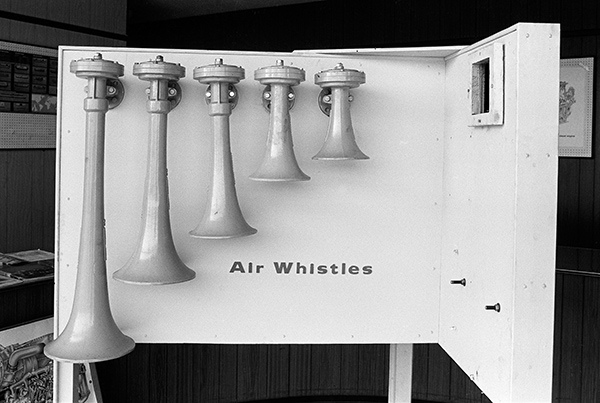
28j44: Air Whistles, Great Union St, 1981 – East Hull
I think this office on Great Union St was roughly opposite Hyperion St. As well as air whistles you could also order a diesel engine and other things you might need for your ship. The site is now occupied by The Crossings, a centre for the homeless which opened in 2011.
In the book ‘Still Occupied’ I placed this image in the East Hull chapter, though it would have been more sensibly in the River Hull chapter, close to the river and with an obviously strong connection.
I also took a second picture through the same window, this time concentrating on the reflection and seeing the line of whistles only dimly through it.
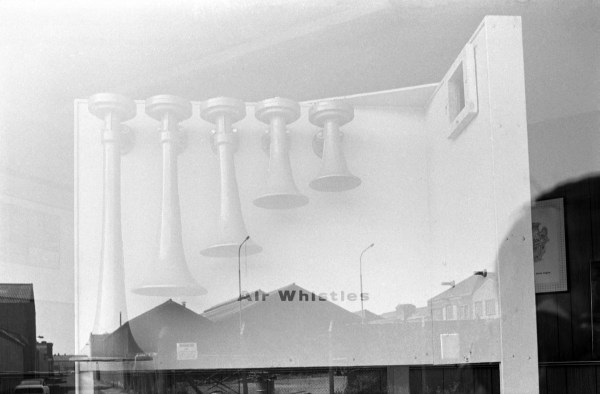
28j45: Air Whistles, Great Union St, 1981 – East Hull
I think in 1981 I preferred the second version, with the air whistles floating rather insubstantially above the roofs opposite, but it was the first image that I chose for the book in 2011.
10th February 2017
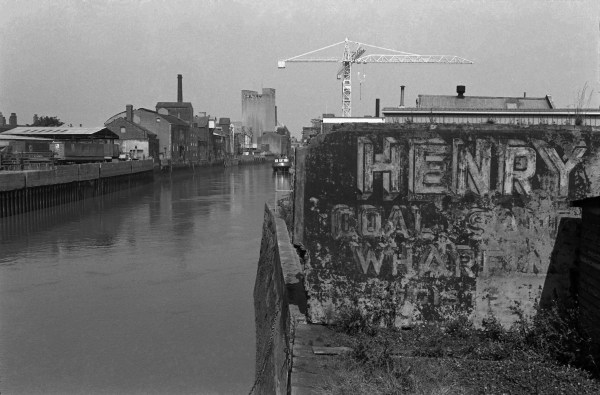
28j54: River Hull view upstream from North Bridge, 1981 – River Hull
Peeling paint on a wall advertises the coal and sand wharf belonging to ‘Henry’, which I think may be Henry Mead & Co at 15 Lime Street, which was wound up in 1973. On the west bank of Hull are a long line of wharves and buildings on Wincolmlee, with the towering silos of R&W Paul (now Maizecor) in the distance. A single vessel is visible moored at one of the Lime St wharves.
Floods from the Hull, mainly because of a tides coming up from the Humber, were fairly frequent before the tidal barrier was built, because the corporation failed to get wharf owners to maintain adequate flood defences. A number of derelict properties made their job more difficult. More recent floods have been because of excessive rainfall in the Hull valley.
11th February 2017
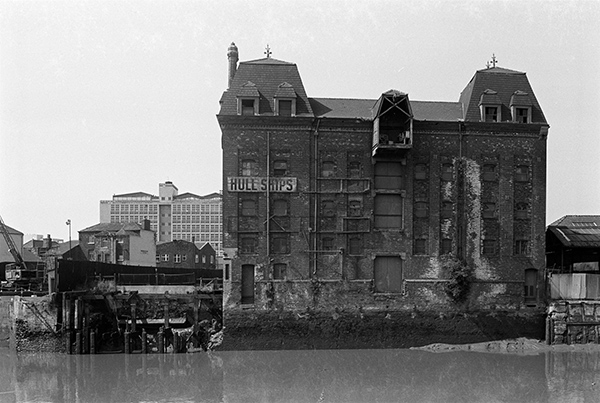
28j55: North Bridge Warehouse (Hull Ships Stores c.1850), Charlotte St, 1981 – River Hull
The old North Bridge replaced a ferry here in 1541, and the remains of the old bridge (many times renewed) can be seen to the left of the warehouse in my picture. It was replaced by the current Grade II listed bascule bridge in 1928-30. Above the ruins is the large building of Hull College and in front of that the buildings, some Georgian, of Dock Office Row.
Hull Ships Stores, a ship supplies warehouse built in 1870, architect RG Smith, were Grade II listed in 1994, a few years after they were converted into flats as Northbridge House.
12th February 2017
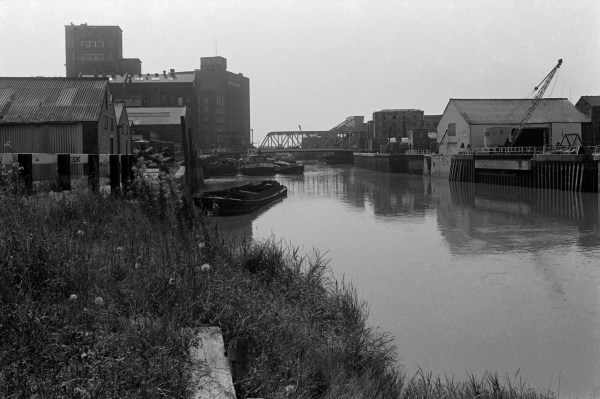
28j56: River Hull, view south from the east bank below North Bridge, 1981 – River Hull
The path on the east side of the River Hull between North Bridge and Drypool Bridge was blocked in 1981, but limited access was possible. This picture was taken close to North Bridge looking south towards Drypool Bridge.
The Rank (later Rank Hovis) Clarence Flour Mill immediately left of the bridge opened in 1891, designed by one of Hull’s best known architects, W. Alfred Gelder. Much of the mill was destroyed in heavy wartime bombing in 1940, when Hull was often used as a secondary target by any bombers who had failed to drop them in Leeds, Sheffield, Manchester, Liverpool etc, and was one of the most heavily bombed of all UK cities. When I was taking these pictures older Hull residents still complained that their city was never named in the wartime reports of bombing, just referred to, if at all, as “a north-east city.”
The tall silo is mostly the original Victorian build but the mill was rebuilt and enlarged post-war. This former Hull landmark was demolished in 2016.
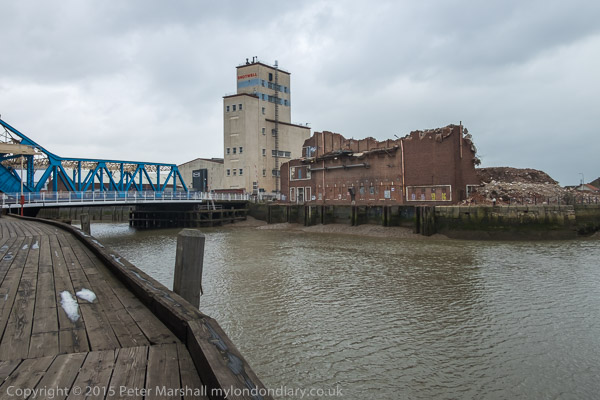
Obscuring much of the mill is another brick building which was probably a part of the Gamebore Cartridge Co. Ltd, whose Shotwell Tower at the left still produces the lead shot for use in their world-leading shotgun cartridges.
At the right of the picture are the gates of the Yorkshire Dry Dock, with a crane, and beyond them what remains of the entrance to Queen’s Dock Basin which used to lead into Queens Dock, filled in as a rather dull and still part-sunken public park in 1930-34.
13 February 2017
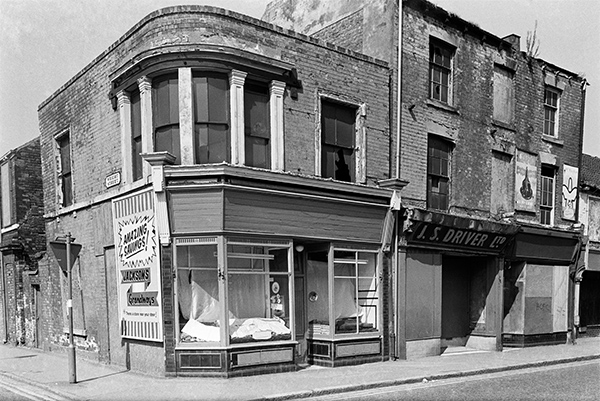
28j62: Wright St & Charles St corner, 1981 – City Centre
Both Wright St and Charles St still exist on the map of Hull, but they no longer meet as they used to, and the surrounding area has been changed by the building of the Freetown Way, opened in 1986, five years after I took this picture.
Charles St was on the northern edge of Hull when it was developed by the Rev Charles Jarratt in the 1830s and 1840s, and there are still a few buildings from that period surviving in both it and Wright St.
Although there are broken windows and boards over the shops at right, the corner shop appears to be still in business, though not open early on a Sunday when I took the picture. Under the cloths in the windows are what look like cakes or doughnuts, and the notice in the doorway states ‘Golden Touch Bingo Vouchers Accepted Here’.
Charles St has been described as a long street of almost continuous small shops where you could buy almost anything you might ever need. And of course pubs. And it was in this street that one of the least likely ‘Jack the Ripper’ suspects, writer and journalist Robert Donston Stephenson (aka Roslyn D’Onston) was born. He was in the London Hospital when Mary Ann Nichols, the first ‘Ripper’ victim was killed only a couple of hundred yards away, and took a great interest in the case, suggesting an unlikely link to occult practices which he had studied. Others suggested he might really have been the murderer, not least because his wife had disappeared without trace a couple of years earlier. Of course there is really no mystery about the ‘Ripper’, just a huge industry of profit in denying the facts.
14 February 2017
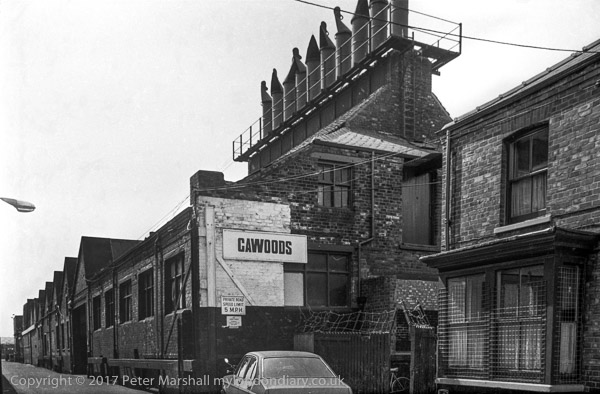
28k11: Cawoods, Essex St, Gipsyville, 1981 – Hessle Rd
The Dairycoates (Gipsyville) Industrial Estate is a couple of miles west of the city centre and was purpose-built with 8 streets of terraced housing named after English counties running south from the Hessle Rd around 1900. THe first companies there were F. Atkins & Co making canisters (later they became part of ‘Metal Box’ and then moved away) and Hargreaves Bros, & Co, a black lead company, whose “Gipsy Black Metal Polish” gave the whole area its name, including the extensive inter-war council housing to the north. The industrial estate was enlarged in the 1980s, with large factory sheds of little interest.
Cawoods fish curing works are the most distinctive part of the estate, and they produced dried salted fish in Hull for around a hundred years. There Grimsby factory came later, and they moved all production there in 2002, a few years before the Hull fish market closed.
15 February 2017
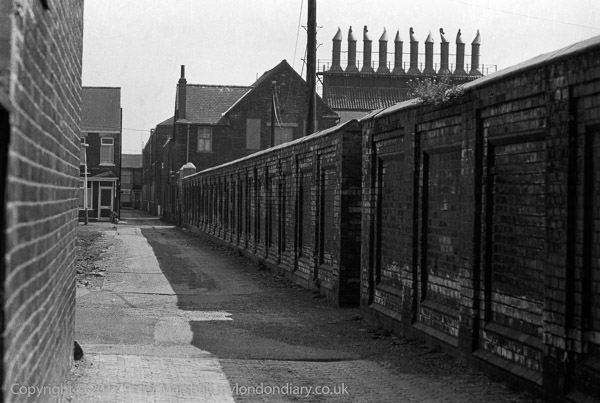
28k22: Tenfoot, near end of Essex St, Gipsyville, 1981 – Hessle Rd
A ‘tenfoot’ is any side or back alley, often 10 foot wide, though not always. There are also some ‘twentyfoots’ in Hull. Some tenfoots are now gated, while others have been recognised as public rights of way – restricted byways. In some places they were used by refuse collectors and others making deliveries, as well as play areas by the local children, but in other areas are seen as problem areas with fly tipping, access for burglaries, drug-taking and sex. Gating them is currently a controversial subject in some areas of Hull.
This tenfoot runs along the end of all of the 8 streets of terraced housing built around 1900 as workers housing for the Dairycoates industrial estate, with a long brick wall on the south side. There were a couple of entrances to the estate from it, from one of which I took the previous picture.
You can see the new pictures added each day at Hull Photos, and I post them with the short comments above on Facebook.
Comments and corrections to captions are welcome here or on Facebook.
______________________________________________________
There are no adverts on this site and it receives no sponsorship, and I like to keep it that way. But it does take a considerable amount of my time and thought, and if you enjoy reading it, a small donation – perhaps the cost of a beer – would be appreciated.
My London Diary : Buildings of London : River Lea/Lee Valley : London’s Industrial Heritage
All photographs on this and my other sites, unless otherwise stated, are taken by and copyright of Peter Marshall, and are available for reproduction or can be bought as prints.